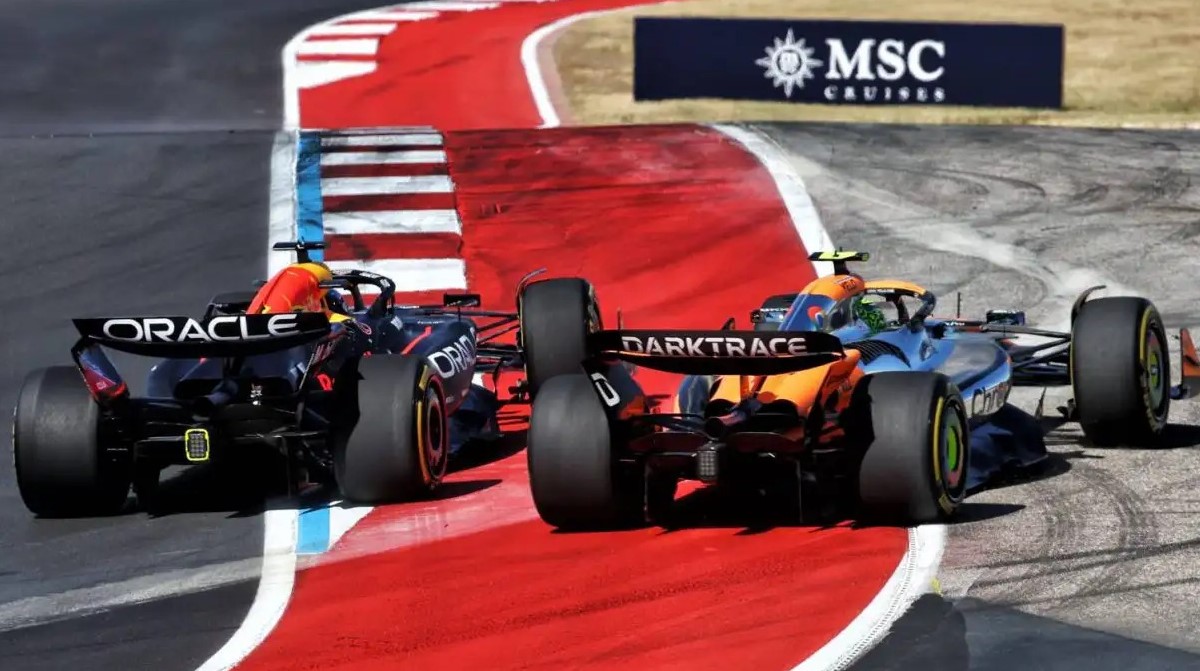Martin Brundle claims F1 rules and guidelines ‘dissuade overtaking’ in light of controversial Lando Norris penalty after heated duel with Max Verstappen at the United States Grand Prix.
The race which concluded with a stunning one-two finish for Ferrari’s Charles Leclerc and Carlos Sainz, was overshadowed by the fallout from Norris penalty for overtaking Verstappen off the track.
Sky Sports F1 commentator Martin Brundle has voiced his concerns, labeling the current F1 rules as a “blueprint to dissuade overtaking,” igniting discussions on how these regulations impact racing dynamics.
The incident unfolded during the closing laps of the United States Grand Prix race when Norris, in a fierce battle for third place, executed an overtaking maneuver on Verstappen at Turn 12. As both drivers navigated the corner, they found themselves running wide, with the McLaren ultimately gaining the position after leaving the track.
The stewards deemed this maneuver illegal, citing that Norris had lost his “right” to the corner by not being level with Verstappen at the apex. Consequently, he received a penalty that not only stripped him of a podium finish but also cost him valuable championship points in his ongoing battle against Verstappen.
Brundle’s critique centers on the inconsistency and complexity of F1 rules, which he argues create an environment where overtaking is discouraged. He highlights that while the rules aim to clarify acceptable conduct during close racing, they often lead to confusion and frustration among drivers and teams.
The guidelines stipulate that a driver must have a significant portion of their front axle alongside their rival to be afforded space; however, this leaves room for interpretation and potential manipulation of the rules.
“As far as I’m concerned, the six-page Guidelines (therefore not regulations), which have been signed off by the FIA, the drivers’ association (GPDA), and the teams, are a blueprint to dissuade overtaking, especially around the outside,” Brundle wrote in his Sky Sports column.
“There are key reference points that are hard to define for both drivers and stewards, such as where exactly is the apex of any given corner across the entire width of the track, along with specific front axle and car mirror positions in a fast-moving event such as a racing overtake.
“I don’t know what happened to the ‘let them race’ approach from a while back which worked reasonably well.
“As far as I’m concerned, if you pass a car on the inside of a corner, while remaining under control and not locked up, and keeping within the track confines, then you have won the corner and can take the normal racing line through the exit, and it’s up to the driver who has been passed to yield, not to hit the throttle and inevitably run wide.”
The controversy surrounding Norris penalty at the United States Grand Prix is compounded by previous incidents in the race where other drivers faced similar sanctions for off-track overtakes which raise questions about fairness and consistency in officiating.
For instance, George Russell was penalized earlier for forcing Valtteri Bottas off track, yet Verstappen escaped similar scrutiny despite his role in pushing Norris wide. This inconsistency has led to calls for a reevaluation of how penalties are applied and how rules are interpreted during races.
“Russell took an unreasonable penalty in Austin because the guidelines had to be applied,” added Brundle.”If Russell was penalised for running Valtteri Bottas wide, shouldn’t Verstappen have been penalised for running Norris wide at the same corner?
“And here’s another question, given Norris had passed Verstappen down the outside before Turn 12, when Verstappen sailed back up the inside, who was actually doing the overtaking at the corner apex, Verstappen or Norris?”
Meanwhile, former F1 driver Anthony Davidson points out that the design of modern circuits contributes to these issues. With expansive run-off areas and complex corner layouts, drivers often find themselves in situations where they must choose between maintaining control and adhering to track limits.
This dilemma can lead to penalties that seem unjust, particularly when both drivers involved in an incident have transgressed track limits simultaneously.
“We witnessed back at the Austrian GP where a simple channel of gravel and other circuit furniture can dissuade driving off the defined racetrack, without having high kerbs which can dangerously launch cars into the air,” Davidson said.
“It costs money to replace and return this for motorcycle racing where it simply doesn’t work, but in the grand scale of F1 things that’s not expensive. The circuit layouts and run-offs create the problems, and the ever more complex driving rules fail to manage all of the inevitable and varied issues.
“Don’t simply blame the referees, that’s not fair and won’t solve the problem. The F1 rules need a serious tweak, and much simplification.”






